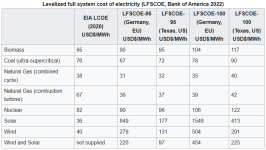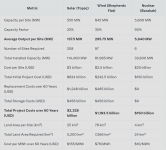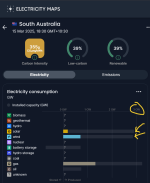No matter what type of electricity is used, if there’s a monopoly in place, prices are likely to rise. This is a classic case of supply and demand — a dynamic that applies across all markets, even for something as simple as bananas.
IMO, wind and solar projects often result in super-monopolies, as their viability typically hinges on significant government support.
I just thought I would add such a video for completeness..

Electricity prices have gone up by a lot as wind/solar renewables have been rolled out in Australia, especially in South Australia.
Here is chatGPT's table, ~15cents to as high as ~52c/kWh over a 22year period for South Australia. I have looked through chatGPT's "sources" websites in the chatlog these claims are if anything an understatement.
Shared via ChatGPT

chatgpt.com
Adelaide, South Australia, from 2003 to 2025, expressed in cents per kilowatt-hour (c/kWh):
| Year | Average Retail Price (c/kWh) | Highest Reported Retail Price (c/kWh) |
|---|
| 2003 | ~15 | ~20 |
| 2005 | ~17 | ~22 |
| 2008 | ~20 | ~25 |
| 2010 | ~22 | ~28 |
| 2013 | ~26 | ~32 |
| 2016 | ~30 | ~38 |
| 2019 | ~32 | ~40 |
| 2022 | ~35 | ~45 |
| 2025 | ~38 | ~52.5 |
One thing I always notice is how mainstream media and government officials keep repeating the phrase, “we are still transitioning to renewables.”
But South Australia already has around 400% wind and solar installed capacity relative to its average demand, and Victoria is not far behind at about 200%.
So how much is enough before we stop calling it a “transition”? At this rate, it seems like we’ll still be “transitioning” even at 1,000% capacity.
Here are some basic electricity stats to consider for South Australia.
The state of South Australia has one of the smallest populations at just 1.7 million people for the whole state.
And they have
- ~3GW of installed active windfarm capacity.
- ~3GW of installed active solar capacity.
- Pretty big battery storage
- SA consume about ~1.5GW of electricity on average, so this means SA has about 400% wind/solar capacity installed.
The Wikipedia for SA states just 1.33GW
11,614 GWh / 8,760 hours ≈ 1.33 GW

en.wikipedia.org
- SA has what really appears to be the best wind in Australia via the "Great Australian Bight" coastal geology, where the wind blows in from the very long bending coast line into the state. Any other state in Australia gets less wind than SA at least for onshore wind setups (IMO), so every other state that tries to copy SA renewables setup will have a more difficult time utilizing wind renewables.
- SA also has a large interstate grid connection with Victoria, so when things get tough on their own wind/solar/gas/Tesla-battery they can draw on Victoria's coal electricity when needed.
View attachment 367843
But despite having ~400% wind/solar renewables, South Australia just can't really get enough wind/solar/battery to make a utopian state of cheap electricity.
The most recent 2025 price updates for retail electricity in SA shows how bad it has gotten in cents/KWh, as Canstarblue details below. These prices are advertised general usage prices where you are supposed to say "ooh that's a good deal"..
How much are electricity rates in South Australia? Learn everything you need to know about energy usage costs and supply charges.

www.canstarblue.com.au
Here are just some of the prices for the long chart they have, some retailers list prices as high as 61.60¢/kWh, but it is often reported that SA is at ~50cents/KWh by most MSM
| Electricity provider | Electricity plan | General usage rate | Daily supply charge |
|---|
| AGL | Residential Value Saver – New to AGL | 41.98¢/kWh | 108.03¢/day |
| Alinta Energy | Carbon Balance – Single Rate | 44.88¢/kWh | 104.90¢/day |
| Amber Electric | Amber Plan – Variable Wholesale Prices | 45.82¢/kWh | 108.87¢/kWh |
| CovaU Energy | Freedom | 45.60¢/kWh | 101.06¢/kWh |
| Diamond Energy | Everyday Renewable Saver | 46.05¢/kWh | 88.00¢/day |
MSM headlines on how electricity keep prices keep going up.

www.9news.com.au

www.9news.com.au
The state and federal government has put in a lot of the money to build these wind/solar projects, and it really appears their belief was that electricity prices would go down.
When prices didn't go down the government started giving rebates directly to consumers, I can only assume the gov thought that once even more wind/solar was online then finally electricity prices would get cheaper. That never happened.
Even the richest Australian will receive cost-of-living help, the prime minister insists, because pressures are felt throughout the income scale.

www.sbs.com.au
Struggling households in three states are being denied energy bill relief because of a bureaucratic hold-up.

www.dailymail.co.uk
If wind/solar is so cheap, then just build more solar/wind and battery right? Well when you're at 400% then how much is enough?
They have upgraded their big battery multiple times now.
Obviously SA has hit the end of the road in terms of "diminishing returns" with deployment of renewables, there is no where to turn but to do something else, IMO.
Anyone who says "but big batteries will get cheaper" are also being constantly proven wrong, since the costs of
building the big Tesla grid batteries in Australia has since more than tripled in costs from the famous big Tesla battery (Hornsdale Power Reserve) in 2017, to the most recent big Tesla battery in Australia called the Melbourne Renewable Energy Hub (MREH)

en.wikipedia.org
The Melbourne Renewable Energy Hub (MREH) is so expensive it doesn't even have a Wikipedia page because they don't want you to notice how expensive it is (IMO)

.

www.secvictoria.com.au
View attachment 367982
It is rare to see the Victorian government provide transparent statistics or cost disclosures on renewable energy projects. Based on available information, the cost likely exceeded $1.2 billion — with the listed $1.2b, it's likely in US dollars (IMO) and considering it is using USA battery technology.
Mainstream media explanations for rising electricity prices since the integration of renewables often border on the absurd, as they tend to blame nearly everything except renewables themselves.
A common excuse is that "poles and wires" are driving up costs, yet if renewable energy is genuinely inexpensive, why hasn't this issue been resolved? South Australia began deploying wind farms nearly two decades ago. If significant cost reductions were coming, shouldn't we have seen them by now?
In my opinion, the evidence suggests that large-scale investments in wind and solar offer limited returns compared to nuclear.
The cost and complexity of managing intermittent renewables grow with demand, making them increasingly difficult to scale efficiently.
For example, the gov shut down five solar farms in Victoria due to fire risks, apparently there was even a fire during their last inspection.
Safety authority’s inspection blitz after fire sees five small solar farms closed until grass and vegetation is brought under control.

reneweconomy.com.au
These were pretty small solar farms, and to reach solar renewables utopia we are supposed to be aiming for thousands of square kilometres of solar to get off fossil fuel generation.
What convinces me most that renewables are not a viable solution is the secrecy and lack of transparency around the full costs of these projects. Major U.S. developments like the Topaz Solar Farm and Shepherds Flat Wind Farm appear to demonstrate that large-scale wind and solar aren't truly cost-effective, and since then, the total costs of most new projects are rarely disclosed.
There are plenty of large wind and solar projects in countries known for transparency, like the U.S. and Australia, yet it's surprisingly difficult to find clear, complete cost information.
When AI generates tables and the data checks out, it becomes clear to me that wind and solar are driven more by ideology and misinformation than practicality — and in some cases, even resemble a scam.
Here is my latest comparison of comparing wind, solar and nuclear using real world project costs to power Australia.
This time the question provided to AI is quite large with the core data inputs like project costs inserted into the question, this is all publicly available very easily findable data. I did it this way so that both AIs couldn't leave anything for interpretation, thus we get nearly
identical answers from both Grok and chatGPT, except for some basic rounding off..
Shared via ChatGPT

chatgpt.com
| Parameter | Solar (Topaz Solar Farm) | Wind (Shepherds Flat Wind Farm) | Nuclear (Barakah Nuclear Power Plant) |
|---|
| Annual Net Output per Unit | 1,282 GWh | 1,677 GWh | 44,150.4 GWh
(= 5,600 MW × 0.90 × 8,760 ÷ 1,000) |
| Initial Construction Cost per Unit | $2.4 Billion | $2.0 Billion | $32 Billion |
| Land Area per Unit | 25 km² | 78 km² | 6 km² |
| Lifespan | 25 years | 20 years | 60 years |
| Capacity Factor | 25% | 22.7% | 90% |
| Capacity per Unit (MW) | 585.4 MW
(= 1,282×1,000 ÷ (8,760×0.25)) | 843.7 MW
(= 1,677×1,000 ÷ (8,760×0.227)) | 5,600 MW (fixed) |
| Average Output per Unit (MW) | 146.3 MW
(= 1,282×1,000 ÷ 8,760) | 191.5 MW
(= 1,677×1,000 ÷ 8,760) | 5,040 MW
(= 44,150.4×1,000 ÷ 8,760) |
| Number of Units Required | 195 units
(= Ceiling(250,000 ÷ 1,282)) | 150 units
(= Ceiling(250,000 ÷ 1,677)) | 6 units (fixed) |
| Total Installed Capacity | 114,150 MW
(= 195 × 585.4) | 126,555 MW
(= 150 × 843.7) | 33,600 MW
(= 6 × 5,600) |
| Initial Project Cost | $468.0 Billion
(= 195 × $2.4B) | $300.0 Billion
(= 150 × $2.0B) | $192 Billion
(= 6 × $32B) |
| Replacement Costs | $936.0 Billion
(2 replacements: 2×468.0) | $900.0 Billion
(3 replacements: 3×300.0) | $0 Billion |
| Battery Storage Capacity per Unit | 1.4634 GWh
(= 1,282 ÷ 365 ÷ 24 × 10) | 1.9161 GWh
(= 1,677 ÷ 365 ÷ 24 × 10) | 0 GWh (none required) |
| Total Storage Capacity & Cost | 285.66 GWh
(= 195 × 1.4634)
$570.73 Billion
(= 195 × [1.4634×0.5×4]) | 287.42 GWh
(= 150 × 1.9161)
$574.83 Billion
(= 150 × [1.9161×0.5×4]) | 0 GWh; $0 Billion |
| Total Project Costs | $1.97 Trillion
(468.0 + 936.0 + 570.73) | $1.77 Trillion
(300.0 + 900.0 + 574.83) | $192 Billion |
| Cost per MWh | $132 per MWh
(= Total Cost ÷ [195×1,282×60×1,000]) | $118 per MWh
(= Total Cost ÷ [150×1,677×60×1,000]) | $12 per MWh
(= 192B ÷ [6×44,150.4×60×1,000]) |
| Total Land Area | 4,875 km²
(= 195 × 25) | 11,700 km²
(= 150 × 78) | 36 km²
(= 6 × 6) |
From Grok AI
| Metric | Solar (Topaz) | Wind (Shepherds Flat) | Nuclear (Barakah) |
|---|
| Annual net output/unit | 1,282 GWh | 1,677 GWh | 44,150 GWh |
| Initial cost/unit | 2.4 Billion USD | 2 Billion USD | 32 Billion USD |
| Land area/unit | 25 km² | 78 km² | 6 km² |
| Lifespan | 25 years | 20 years | 60 years |
| Capacity factor | 25% | 22.7% | 90% |
| Capacity/unit | 585 MW | 843 MW | 5,600 MW |
| Average output/unit | 146 MW | 191 MW | 5,040 MW |
| Number of units | 196 | 150 | 6 |
| Total installed capacity | 114,660 MW | 126,450 MW | 33,600 MW |
| Initial project cost | 470.4 Billion USD | 300 Billion USD | 192 Billion USD |
| Replacement costs | 940.8 Billion USD | 900 Billion USD | 0 Billion USD |
| Total storage capacity | 287 GWh | 287 GWh | 0 GWh |
| Total storage cost | 574 Billion USD | 574 Billion USD | 0 Billion USD |
| Total project costs | 1.985 Trillion USD | 1.774 Trillion USD | 192 Billion USD |
| Cost per MWh | 132 USD/MWh | 118 USD/MWh | 12 USD/MWh |
| Total land area | 4,900 km² | 11,700 km² | 36 km² |
You can verify that the core input data aligns with the retrospective Wikipedia pages for each energy project. I even ask the AI to provide “copy link to highlight” URLs in the chatlog to help others cross-check the sources directly.
Using these inputs, both AI models produced nearly identical results, which I believe offers a reliable snapshot of the true costs involved in scaling renewables to power Australia.
Interestingly, some reports in the mainstream media suggest that there is growing support in South Australia for a nuclear power station — likely because the state has reached the limits of what can feasibly be achieved with wind and solar.
In my view, the main reason nuclear is perceived as far more expensive than other energy sources is due to its large upfront capital cost.
However, most wind and solar projects present misleading figures for installed capacity — typically generating only 25% to 30% of that number on average. In contrast, nuclear power plants usually operate at around 90% of their rated capacity. Unfortunately, the comparison is often made using the headline megawatt figures, without accounting for this significant difference in capacity factor.
A typical large nuclear power plant project would have around x10 times more of the construction costs than a "large" wind/solar project, but for that cost the nuclear plant is typically creating around x40 times more electricity annually and lasts x3 longer in life span.
An example would be like if you could buy a commercial self driving truck to deliver goods, and the choice was one that would last x3 times longer and could transport x40 times more cargo then a cheaper truck, then the choice would be obvious, but this is what tricks most people, IMO.
It actually does boil down to being that simple, what the AI is great at doing is boiling down everything publicly available into a simple few numbers in a table, and the results make wind/solar look very silly, IMO.
My goal is to identify other large wind and solar projects and use AI to compare them with nuclear projects, particularly to see if their total construction costs come anywhere close to nuclear.
What’s striking is how difficult it is to find wind or solar projects — even in the U.S. or Australia — that have fully disclosed costs. Despite the scale of these projects, very few publish complete financial details.
Putting everything else aside, the idea that it’s feasible to manage a 4,000 to 11,000 km² renewable project only makes sense to those who, in my view, prioritize belief over logic — a clear case of mental gymnastics.






















